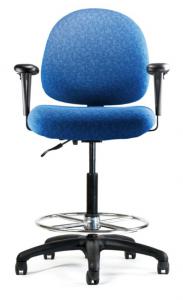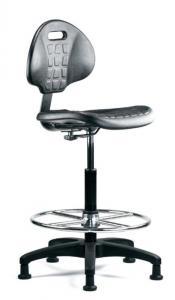What Type of Chairs are Best for Laboratories & Industrial Facilities?
Read what to look for when specifying chairs for your wet lab, cleanroom, electronics manufacturing factory, or industrial facility?
AUSTIN, TEXAS, USA, September 30, 2019 /EINPresswire.com/ -- Are you having trouble deciding on which chairs to specify for your wet lab, cleanroom, electronics manufacturing factory, or industrial facility?We take a look at the important details that you need to consider for these demanding environments – from choosing the right materials that can resist chemical spills to ergonomic considerations that keep your employees healthy and fit while on the job.
These task chairs offered by Formaspace are suitable for a variety of activities and body types. They provide smooth mobility and essential back support while also accommodating movement.
Wet labs create an exceptionally demanding physical environment.
Accidental chemical spills are always a risk, so you need to choose your chair specifications carefully.
Ordinary fabric upholstery is usually a poor choice, due to their inability to resist chemical exposure without staining; also, ordinary upholstery fabrics can absorb and retain unpleasant chemical odors, especially at the seams.
The tough Graphite chair is an ideal choice for wet labs where accidental chemical splashes and spills are a constant risk.
Instead, take a look at fully enclosed urethane seating designs with minimal seams, which make them easier to clean and maintain, as well as providing greater resistant to multiple chemical exposures.
Because the majority of wet lab designs are designed with countertop height work surfaces, you’ll need to select chairs that incorporate durable foot rings or platform-style footrests — to prevent ‘dangling feet’ that can cause unnecessary worker fatigue. Footrests and platforms made from metal are long-lasting and may be more resistant to the demands of especially harsh wet lab environments compared to conventional “composite” ones, e.g. those made from molded plastic.
Finally, to facilitate lab workers shifting from one area of the lab to another, you’ll want to specify heavy-duty hard floor casters.
Providing suitable seating for cleanroom environments is a challenge.
Ordinary furniture seating systems are out of the question — as their friable upholstery fabrics and hard-to-clean surfaces can generate and collect dust particles.
What to do?
Well, if your cleanroom application is rated between Class 100,000 (ISO 8) and Class 100 (ISO 5)*n there is now a solution: seating systems that are specially designed for high-performance cleanroom operations.
GEO chairs are unique in the industry: they are certified use in cleanrooms up to Class 100 (ISO 5).
How can these comfortable chairs, with their 3-Function adjustable seating mechanisms, comply with the demands of Class 100 (ISO 5) cleanroom environments? The answer lies in their unique, smooth, sealed plastic seating surfaces that are easy to wipe down, while at the same time designed to prevent collection or shedding of particulates into the ambient air.
If your cleanroom application is even more demanding — e.g. Class 10 (ISO 4) or Class 1 (ISO 3) environments — Formaspace can custom manufacture metal seating
Many of Formaspace’s industrial customers, such as Dell Computer, work with delicate electronic devices that can be catastrophically damaged by unintentional electrostatic discharge.
That’s why such a wide variety of our Formaspace industrial clients — including electronics manufacturing and assembly operations, electronics testing and repair labs, and tech labs that handle and configure expensive servers — take advantage of our ESD (Electrostatic Dissipative) furniture configurations, which have ESD work surfaces built into the furniture — to provide a robust, practical solution for avoiding accidental electronic static discharge.
Of course, all the ESD protections in the world mean nothing if the chairs you use aren’t designed to prevent accidental static discharge as well.
Adapta chairs are an ideal solution for electronics manufacturers that require ESD (Electrostatic Dissipation) protection for sensitive microelectronics gear.
It’s easy to check if the seating used in your facility has dissipative protection features. The most common telltale sign is a drag chain mounted underneath that allows static discharge to your dissipative floor.
But there is more to the story than a drag chain or caster clip. Properly designed chairs used in ESD environments are designed from the ground up (pardon the pun) to absorb and redistribute the human body’s natural tendency to accumulate static electricity.
It’s also important to specify chairs that have been completely assembled and individually tested at the factory to be assured of complete ESD protection — buying seating that requires on-site assembly without sophisticated testing can lead trouble down the line, so to speak.
Another purchasing consideration is the ergonomic comfort of your employees, who typically work long hours on highly detailed, highly-precise tasks that require intense concentration. Investing in comfortable seating will help reduce discomfort and help prevent injuries — an important consideration, given that the average preventable injury can cost employers more than $100,000 per incident.
Industrial applications — from factory assembly lines to packing stations at distribution centers — are tough environments where employees work long hours, often with three shifts operating 24×7.
That’s where industrial furniture from Formaspace excels.
Industrial seating is no different.
It’s critical to specify chairs that are built tough — from the get-go.
Selecting the right upholstery surface is critical. Instead of traditional cloth fabric, consider specifying tough yet supple surfaces — such as molded urethane or vinyl upholstery — that resist tearing (when nicked with a box cutter, for example) and are easy to clean when exposed to dust and dirt, as well as common industrial spills, including oils and lubricants.
The Graphite chair is designed for tough industrial work environments. Its molded urethane seating surfaces are easy to clean and long-wearing.
Ergonomics are also important to consider. Workers in industrial settings put in long hours, and they need good support to reduce back pain and other injuries caused by repetitive strains on the job. Chairs that can be easily adjusted to fit different-sized workers are a must, as are chairs that can accommodate different height work-surfaces — including height-adjustable ones.
It’s important to provide a place for workers to rest their arms, so if they are not working exclusively at a desk-like environment, you should specify ergonomic armrests.
Taller workstations mean taller seating, so employees will need a comfortable place to rest their feet — with suitable foot rings or built-in platforms at the base of the chair.
Finally, mobility is important for many facilities. If you choose casters, select heavy-duty ones to ensure a secure footing for employees when seated while offering the flexibility of being able to move the chair around easily from task location to task location.
Read more ... https://formaspace.com/articles/wet-lab/lab-designs-mimicking-flexible-offices/?utm_source=einpresswire&utm_medium=content&utm_campaign=article-092419
Mehmet Atesoglu
Formaspace
22792792
email us here
Legal Disclaimer:
EIN Presswire provides this news content "as is" without warranty of any kind. We do not accept any responsibility or liability for the accuracy, content, images, videos, licenses, completeness, legality, or reliability of the information contained in this article. If you have any complaints or copyright issues related to this article, kindly contact the author above.




